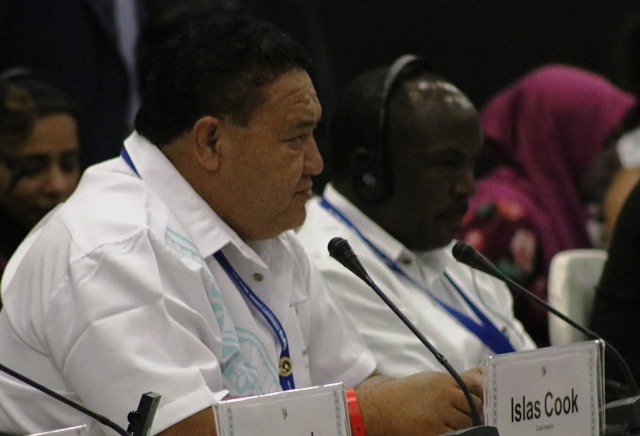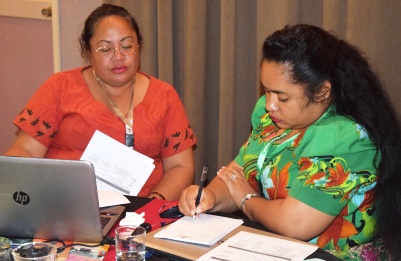
Climate Change Resilience
 Ilustrations developed, capturing conversation during PICOF-2
Ilustrations developed, capturing conversation during PICOF-218 October 2016, Nadi, Fiji - Eight to ten Tropical Cyclones expected to be named are forecast for the Pacific island region this cyclone season, with elevated activity to the North of the Coral Sea and close to the international dateline near Tonga and Niue. This was announced at the Second Pacific Islands Climate Outlook Forum (PICOF-2).
PICOF-2 brought together national and regional Pacific island met staff, international experts, and and representatives of key Pacific island priority sectors including disaster management to discuss the seasonal climate outlook and the application of this information to sectoral decision-making, in particular, that in the disaster risk reduction sector.
The joint presentation from the National Institute of Water and Atmospheric Research (NIWA), Australian Bureau of Meteorology, New Zealand Met Service and the Pacific Islands National Met Services shared information based on finding consensus from results of different analog cyclone seasons.
The Tropical Cyclone Season for the Pacific is during the months of November 2016 to April 2017.
"For the Cook Islands, the information to date with the three month forecasting is critical for national disaster management officers to make informed decisions as to the dissemination of information and the preparation of all people, right down to the grass roots level. The forecasting models have given us a hindsight into the sciences applied to make those informed decisions," said Mr Keu Mataroa, of Emergency Management Cook Islands.
This was also echoed by Mr Jerry Hagaria of the Solomon Islands National Disaster Management Office: "This information given to us today was useful, it will help us to start to plan for what is going to happen with the coming cyclone season. We do work with our Met service, they provide us with the forecast and we liaise with our partners to plan the best way to use this information and how people can prepare. The NDMO Programmes Unit develop the media messages and share these through radio so we can reach a wide audience, we also send out press releases for all. We plan to start this outreach work at the end of this month."
 Cook Islands Met and DMO staff at the PICOF-2. Photo: SPREP
Cook Islands Met and DMO staff at the PICOF-2. Photo: SPREP While a regional overview is provided, the best source of information for the tropical cyclone risks at the country level is the national meteorological service," said Mr Sunny Seuseu of the Pacific Met Desk Partnership based at the Secretariat of the Pacific Regional Environment Programme (SPREP).
To help Pacific island communities prepare and respond to the upcoming cyclone season, PICOF-2 will release a Consensus Regional Statement on the Impacts of the 2015/16 El Nino and the 2016/17 Climate and Tropical Cyclone Outlook for the Pacific Islands.
This Statement will include consensus. forecasts of tropical cyclones rainfall, air temperature and sea surface temperatures, based on several agreed- upon models.
The Pacific Islands Consensus Regional Statement will help guide actions and preparations for these events to ensure islands communities are as resilient as possible. The past few years has seen major Category 5 cyclones strike the region with Typhoon Maysak, TC Pam and TC Winston bringing devastation to island communities.
 Tonga Met and DMO staff, paving the way forward, together at PICOF-2. Photo: SPREP
Tonga Met and DMO staff, paving the way forward, together at PICOF-2. Photo: SPREP"We all know the Tropical Cyclone season is ahead, we should all prepare for this regardless, do what you can to prepare – tie your homes down, trim trees close to power lines, prepare your cyclone kits, clear your yard of any possible flying debris," said Ms. Luisa Taunga of the National Emergency Management Office of Tonga.
"Be prepared."
For further information on the Tropical Cyclone Season and the best way to prepare, please contact your National Meteorological Service and National Disaster Management Office.
The Second Pacific Islands Climate Outlook Forum was held in Nadi, Fiji 17 - 18 October, 2016. It brought together national, regional and international experts from the Meteorological Services Sector and the Disaster Risk Reduction, to provide a platform to consolidate seasonal forecasts from multiple sources to issue a consensus climate outlook for the Pacific region. This will include the presentation and discussion of the tropical cyclone outlook for the upcoming season.
PICOF-2 was supported by partners includingthe Secretariat of the Pacific Regional Environment Programme, World Meteorological Organization, Environment and Climate Change Canada, United Nations Development Programme, Australian Bureau of Meteorology, Commonwealth Scientific and Industrial Research Organisation, Climate and Oceans Support Program in the Pacific, Government of Fiji – Fiji Meteorological Service, National Institute of Water and Atmospheric Research, National Oceanic and Atmospheric Administration, Pacific Meteorological Council, University of the South Pacific and the Government of the Russian Federation.
PICOF-2 was undertaken with the financial support of the Government of Canada through the Federal Department of the Environment and), financial contributions made by the Government of the Russian Federation and the Government of Australia.